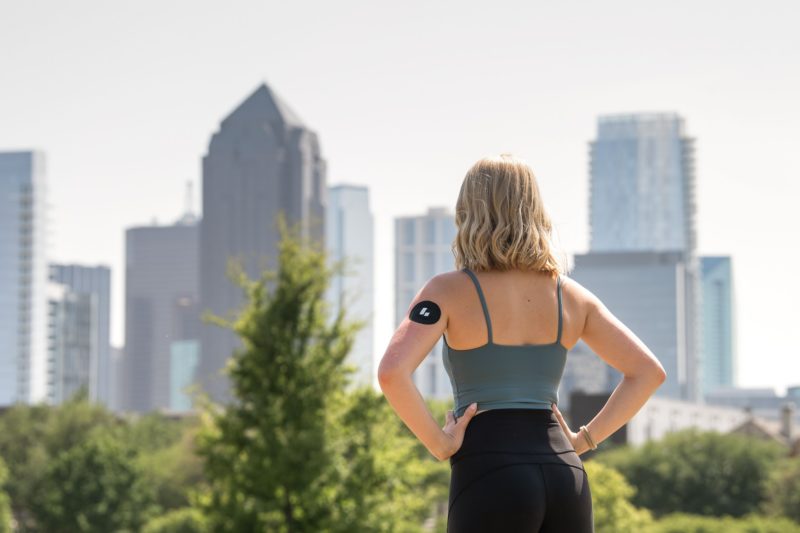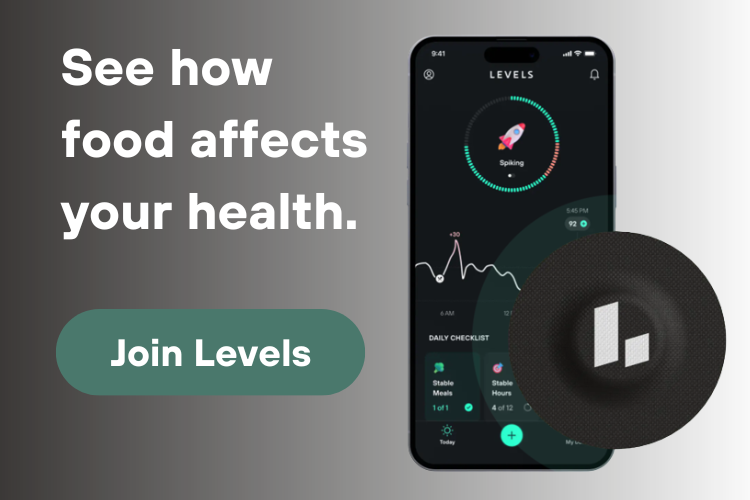The Study: Optimal Metabolic Health Through Continuous Glucose Monitoring
Who’s Running It: Allison Hull, DO and Dominic D’Agostino PhD, at the University of South Florida
What It Hopes to Find: Does Levels and CGM inspire behavior change? Can a data-driven behavioral tool improve metabolic health outcomes over the course of a multidisciplinary 12-week wellness program?
If these researchers see consistent behavior change that leads to more stable and lower glucose as a primary metric, their hypothesis is that they will also see changes in secondary outcomes, including:
- Biometric markers: Weight/BMI, blood pressure, and waist circumference
- Laboratory results: HbA1c, lipid profiles, insulin; blood ketones; hunger and metabolic-related hormones such as leptin, ghrelin, glucagon, GIP, C-peptide
- Inflammatory marker MCP-1 and hs-CRP
- Ultrasound imaging-evaluating fatty liver disease
- Sleep quality and quantity using the Pittsburgh Quality Sleep Index Survey
- Mood changes using the PHQ-9 depression screen and GAD-7 anxiety screen
Methods:
- Randomized, controlled, prospective behavioral intervention clinical trial over 12 weeks.
- Study cohort includes 30 individuals participating in a 12-week, multidisciplinary wellness program.
- All participants are following a carbohydrate-restricted diet.
- 15 randomly selected participants using CGM/Levels software; 15 will serve as control and not use CGM/Levels.
How It’s Using Levels: To provide study participants feedback on their glucose in response to diet and lifestyle to understand the impact on behavior change and health outcomes over the course of a 12-week wellness program.
Timing: Part 1 of the study is complete, part 2 is scheduled for early 2022 with analysis and publication to follow.
More information at yourwellbeingtribe.com.
Learn more:
The Study: Earlier Identification of Prediabetes with Biomarkers from Multiomic Phenotyping: A Systematic Review and Meta-Analysis
Who’s Running It: Sara Gottfried MD, Director of Precision Medicine at the Marcus Institute of Integrative Health and Clinical Assistant Professor in the Department of Integrative Medicine and Nutritional Sciences, with Andrew Newberg MD, Director of Research and Professor in the Department of Integrative Medicine and Nutritional Sciences, at Thomas Jefferson University.
What It Hopes to Find: Dr. Gottfried’s team is investigating the biomarkers that change as someone develops prediabetes, with the aim of being able to better predict that transition from health to predisease. Beyond the standard metabolic markers like glucose and hemoglobin A1C, the researchers are looking at continuous glucose monitoring dynamics; hormones such as adiponectin, insulin, proinsulin, and C-peptide; genomic markers; metabolomics; micro RNA; advanced glycation end products; bile acids, behavioral dynamics, as well as clinical labs like liver function, uric acid, fructosamine, high ferritin, low transferrin, chromium, magnesium, potassium, inflammatory and toxicology biomarkers, and more. Altogether the team will examine approximately 25 categories of biomarkers and compare them to the standard of care for the diagnosis of prediabetes.
In addition, the researchers are exploring distinct phenotypes, or characteristic physiologic profiles of the gene/environment interface, that represent different trajectories towards prediabetes and diabetes. Previously at least three different phenotypes of Type 2 diabetes have been identified, and dense phenotyping of prediabetes may yield a similar discovery.
Methods:
The team is performing a systematic review and meta-analysis. Published description of the protocol here.
Currently, the researchers reviewed more than 2,500 citations, and currently are engaged in blinded full-text review of the studies, extraction of the data captured in those studies that meet inclusion criteria, and analysis to compare biomarkers across studies and to the gold standard.
By the end of 2022, the team expects to complete the analysis of the exploratory study of deep phenotyping on 12 diverse subjects. All subjects have been identified and phenotyping performed.
Timing: The team has completed the systematic review of the first category of biomarkers in 2021, and aims to complete their systematic review by the end of Q1 of 2022 with meta-analyses and findings on other categories of biomarkers continuing through 2022.
The Study: Understanding the paradoxical rise in blood glucose in the context of a low-carbohydrate diet and the use of real-time glycemic status to alter behavior
Who’s Running It: Ben Bikman, PhD, at Brigham Young University
What It Hopes to Find: Why do some people who follow a low-carb diet still have elevated glucose?
The researchers’ hypothesis is that this paradox is related to a unique glucagon profile. Glucagon is one of two main hormones—along with insulin—that regulate blood sugar. Where insulin drives glucose levels down, glucagon increases glucose. Protein can spur the production of glucagon, so the study will also look at the role of macronutrients on glucagon levels, and the subsequent effect on blood sugar levels.
Methods:
- A group of low-carb eaters—men and women age 20-50—will be divided into normal glucose and elevated glucose groups.
- Blood draws will look at glucagon, insulin, GLP-1, cortisol, epinephrine, as well as inflammatory markers CRP, TNFa, IL-1b, IL-6, and cholesterol.
- Subjects will wear CGMs for one month.
- In a second part of the study, CGM-wearing subjects will be randomly assigned to consume a load of fat, protein or carbohydrate weekly at the lab and then get blood tests for glucose and insulin at regular intervals right after consuming the macronutrient.
- In a third part of the study, subjects will wear a CGM but be divided into two groups: one using Levels to log activity, such as meals, exercise, and sleep; and the other will not use Levels. The aim is to find the impact of lifestyle changes on glucose profiles.
How It’s Using Levels: All subjects wearing a CGM will use Levels (except one group in the third part of the study).
Timing: The study will complete in April 2022 and publish in the fall of 2022.
The Study: The Effects of a Novel High-Fat Low-Carb Energy Bar on Weighted Hiking Endurance Performance
Who’s Running It: Dr. Philip J. Prins, Department of Exercise Science, Grove City College, Grove City, PA
What It Hopes to Find: The effect of elevated glucose on physical performance in people without diabetes. In addition, researchers are looking at whether people who have never used a CGM or software like Levels can easily get started and use the tools.
Methods:
- Thirty active men between the ages of 18 and 35 with no known metabolic impairment will wear CGMs for a month. During the first two weeks, researchers will collect baseline measurements.
- The participants will be randomly assigned to consume either a low-carb high-fat (LCHF) or high-carb low-fat (HCLF) energy bar, three hours before walking to exhaustion on a weighted incline treadmill.
- Researchers will measure glucose, lactate, and ketones before the workout and at 10-minute intervals during the workout. In addition, they’ll collect several markers of respiratory fitness, such as oxygen consumption.
How It’s Using Levels: Participants will use Levels to capture CGM data including Zone Scores, Metabolic Day Scores, and nutrition logs over the course of the study and performance tests.
Timing: TBD
The Study: The Effects of a Low-Carbohydrate High-Fat Diet on High-Intensity Exercise Performance in Male Recreational Endurance Runners
Who’s Running It: Philip Prins, Grove City College; Tim Noakes – The Noakes Foundation/Cape Peninsula University of Technology; Dominic D’Agostino, University South Florida
What It Hopes to Find: Whether a low-carb diet will impact an athlete’s performance in high-intensity, short-duration exercise. The study looks to question the long-standing belief that high-performing athletes need to fuel with carbohydrates and that fat is an inferior fuel source. A secondary inquiry is whether athletes eating a high-carb diet have higher glycemic variability, insulin levels, and cardiometabolic health.
Methods:
- Subjects will be 12 recreational but strong runners (sub-7-minute mile, run at least 20 miles a week), ages 30-50, with no known metabolic impairment.
- All runners will be randomly assigned to eat either a high carbohydrate low-fat diet (HCLF) or a low carbohydrate high-fat diet (LCHF) for 31 days (all runners will eat both, but the order will be random).
- Subjects will complete a timed mile run and a repeated sprint test before and after each diet intervention
- In addition to data from the CGM, researchers will collect blood samples at the beginning and end of each month, as well as during each running lab session.
How It’s Using Levels: All participants will use Levels software with their CGMs, and researchers will collect glucose data as well as Zone scores and Metabolic day scores.
Timing: TBD
The Study: The physiology of wise leadership and its impact on performance
Who’s Running It: University of Queensland, University of Melbourne, WHOOP
What It Hopes to Find: This study, in collaboration with one of the most prestigious consulting firms in the world, is looking at what physical factors impact leaders’ ability to solve problems and make decisions under pressure. Researchers are looking in particular at sleep, heart rate variability, and glycemic variability. The theory is that great leaders are able to control their own physiology by staying calm in stressful situations and that this may enable them to better focus and make wise decisions. Among the questions the study will answer are:
- Does metabolic health, as measured by continuous glucose levels, impact decision making, attentional control, leadership, and goal attainment?
- Does physiological resilience enable leaders to self-manage under stress and make wiser decisions?
Methods:
- Business leaders participating in the study will wear WHOOP devices for six months and CGMs with Levels for one month to capture physiological responses.
- The leaders will also select a group of people to give them feedback on their decisions and behavior during the study period.
How It’s Using Levels: Participants will wear CGMs and use Levels throughout the study.
Timing: Research complete and in analysis. Publication planned for 2022.
The Study: The Impact of Circadian Alignment, Autonomic Control, and Physiological Feedback on Measures of Resilience
Investigators: Kristen Holmes, William von Hippel, Cindy Kim, Barbara Hamilton.
Participating Institutions: Stanford University; University of California San Francisco; Las Palmas Medical Center
What It Hopes to Find: Using biometric sensors to collect real-time 24-hour physiologic data, the study aims to determine the relationship between heart rate variability, sleep architecture, blood glucose levels, and perceived stress and resilience, as well as assess the impact of circadian alignment and resilience education on these variables.
How It’s Using Levels: A subset of participants will wear CGMs and use Levels for one month of the study.
Timing: Data will be collected in 2022.









